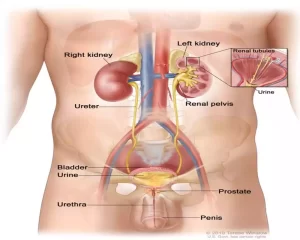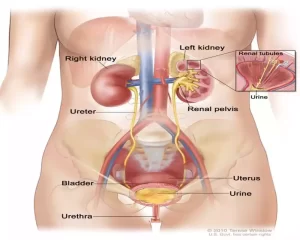The Overview of Male and Female Urine
Urine produced in male and female bodies is of similar composition and composition despite some minor variances between genders, although their reproductive systems differ.
The kidneys produce urine as a liquid waste after filtering out wastes and excess substances in the bloodstream, consisting primarily of water with some waste products such as urea and creatinine; other waste components may include uric and lactic acids along with electrolytes like sodium potassium chloride; this mixture’s composition can vary based on factors like diet hydration level as well as general health issues.
Urine composition may be affected by hormonal influences. Hormones associated with menstruation and pregnancy – estrogen and progesterone, respectively – have small impacts on female urine composition while testosterone, the primary hormone for male sexuality can have minimal if any effects. While these hormonal impacts might seem noteworthy when analyzed routinely, their clinical significance usually does not outweigh these impacts when analyzing urine samples routinely.
Urine tends to have similar colors and smells among both genders, depending on hydration levels, from pale yellow to light brown in hue. Urine scent depends on many different factors including diet, hydration levels, and medication, yet often maintains similar characteristics.
Urine analysis (urinalysis) is used as the standard means of analysis for urine samples, using various diagnostic techniques like dipstick tests, microscopy, and culture methods. Urine tests may be performed on male or female samples to diagnose medical conditions like urinary infections, kidney disorders, or metabolic diseases and can even detect metabolic disease conditions that exist without symptoms – all important ways of monitoring overall health as well as providing early warning signals of infections or metabolic conditions that occur over time.
These differences, while there may be small variations and distinctions in urine composition between genders, usually do not present clinically. Understanding similarities and distinctions in male and female urinary fluids is critical in providing medical diagnoses as well as monitoring any conditions or abnormalities about the urogenital system.implications
Importance of studying and understanding the differences between Male and Female Urine
Studying and understanding the differences between male and female urine is important for several reasons:
- Diagnostic Significance: Understanding the normal ranges and characteristics of urine composition for each gender is integral in providing accurate medical diagnoses. Recognizing variations can aid healthcare providers with understanding test results, detecting abnormalities, or diagnosing conditions specific to men or women.
- Urinary Tract Infections: UTIs affect women more often due to anatomical differences. Understanding differences in female urine composition and increased susceptibility will assist in early diagnosis, prompt treatments, and prevention efforts.
- Hormonal Influences: Women experiencing changes during menstruation and pregnancy often see changes to urine composition due to hormonal influences, including menstruation. Such influences help distinguish normal from abnormal hormonal fluctuations as well as evaluate potential imbalances that might exist within an individual’s system.
- Monitoring Pregnancy: Urine composition may alter due to hormonal shifts or physiological acclimatization during gestation; understanding these fluctuations and studying them is helpful when monitoring pregnancy-related complications using urine tests.
- Research and Advancements: Understanding the differences in male and female urine can facilitate medical research and knowledge advancement, providing insight into potential gender-specific markers or conditions, such as metabolites or biomarkers that could have diagnostic or therapeutic implication. Leading to improved healthcare outcomes and personalized medical treatments for each person.
- Education and Awareness: By raising an individual’s knowledge of the differences and similarities in males’ and females’ urine composition, we can dispel misconceptions and stigmas surrounding bodily functions. Awareness and understanding are crucial in creating health literacy while informing decisions regarding urinary health concerns or any medical needs that may arise.
Understanding the differences in male and female urinary fluids has many applications for medical diagnosis, health management, research, and innovation. Accurate interpretation of urine test results allows for faster identification of gender-specific diseases as well as tailored healthcare.
What is Male Urine?

Men produce urine as waste from their kidneys after filtering waste out of their bloodstream through kidney filtration systems and bladder filtering mechanisms. Urine then travels along its pathway until being finally expelled through the urinary system and through to be eliminated via the urethras.
Male urine, like that produced by females, consists of water mixed with various waste products including urea and creatinine. Other elements may also include uric and lactic acids as well as electrolytes like sodium potassium chloride. This composition of male urinary fluid may change depending on factors like diet hydration health and wellness.
Testosterone, as the primary hormone responsible for male sexuality, may have some impact on both its composition and the volume of urine produced in males. While testosterone’s impact may seem limited compared to other factors, its influence remains noticeable nonetheless; its main function is the developing and functioning of male reproductive organs while having only minimal influence over urine production.
Most differences between male and female urine tend to be subtle and do not have clinical implications. Certain medical conditions or hormonal imbalances that specifically impact men can alter their composition and lead to urinary symptoms that result in changes.
Understanding the composition and characteristics of male urine is integral for medical diagnosis, health monitoring and identification of conditions or abnormalities relating to the urinary tract in men who were born male. Urine tests may be administered clinically as assessments to measure kidney function or detect infections of the urinary tract or medical conditions such as prostate.
What is Female Urine?

Female urine, produced by their kidneys to filter waste out of their bloodstream, passes through the urinary system before eventually leaving through their urethra and out to waste disposal systems.
Female urine, like male urine, contains mostly water with some waste products like urea and creatinine dissolved into it as well as other substances including uric and lactic acids as well as electrolytes like sodium potassium chloride present. Diet, hydration levels, and general health may have an impactful impact on female urinary fluid composition.
Female urine composition can also be affected by hormone influences. Hormonal influences on female urinary systems like estrogen and progesterone may influence urine composition. Their influence tends to be minimal compared with other factors.
Although male and female urine typically differ slightly in terms of its composition, in most instances these differences do not pose significant clinical concerns. Certain medical conditions or hormonal imbalances that specifically impact women may lead to noticeable variations in urine composition as well as urinary symptoms that require medical intervention.
An understanding of female urine composition and variations is vitally important in medical diagnosis, tracking health issues, and detecting abnormalities related to urinary tract function in individuals born female.
Anatomy and Physiology of the Urinary System
The urinary system (also referred to as the kidney system) plays a crucial role in maintaining fluid and electrolyte balance, eliminating waste products, and regulating various body functions. Composed of multiple structures and organs working in concert to produce, store, and eliminate urine efficiently. Here’s an introduction to its anatomy:
Kidneys:
- The kidneys are located near either side of the lower spine. Two kidneys typically exist for every individual.
- The kidneys serve three main purposes: filtering wastes out, regulating fluid and electrolyte balance, and producing hormones to affect blood pressure, red blood cell production, and more.
- The kidneys’ functional unit, the nephrons are responsible for filtering blood and producing urine.
Ureters:
- Ureters are thin muscular tubes connecting each kidney with its urinary bladder.
- The primary role is transporting urine from its source in the kidney to its destination in the bladder through peristaltic contractions.
Urinary Bladder:
- The bladder is an organ located within the pelvic cavity that acts as a reservoir to store urine until its expulsion by the body.
- Its contents increase or decrease in volume, so can its capacity. When stored correctly and functioning optimally, its capacity increases along with it.
- For that reason, bladder size should adjust according to the demand for elimination by increasing or contracting accordingly.
Urethra:
- Urethras are tubes which transport urine from within the bladder out towards its external opening and into circulation for removal from our bodies. This ensures urine removal.
- Male ejaculators pass semen through their urethra during ejaculation.
Sphincter Muscles:
- Two sphincter muscle groups work to control flow.
- At the junction between the bladder and urethra lies an internal urethral muscle that works towards maintaining urinary continence.
- The external urethral muscle can be found at the opening of the urethra and allows conscious control over urine output.
Nervous System Control:
- Autonomic nervous control and conscious command both contribute to maintaining proper urinary function.
- Autonomic nerve systems control automatic functions like bladder contraction and relaxation of sphincter muscle relaxation, without your active intervention.
- Control of Urination allows individuals to either initiate or delay voluntary urination at will.
Filtration and Urine Production:
- Filtration, reabsorption and secretion all play an integral part in producing urine.
- Nephrons filter away waste products such as waste fluid and electrolytes from entering their system through filtering processes.
- Reabsorption refers to the process by which filtrate from nephrons is modified; essential elements are returned into the bloodstream while any unwanted ones stay behind in urine.
- Urine produced in the end contains waste products and substances which must be excreted from our bodies.
Understanding the anatomy of the urinary tract is vital to grasp how our bodies regulate themselves by maintaining electrolyte and fluid balance, eliminating waste effectively, and controlling how waste removal occurs. With this knowledge in hand, doctors are better able to diagnose and treat various urinary disorders or conditions.
Variations in Urine Output
Variations in urine production can be due to any number of causes and may indicate changes in fluid balance, kidney functions, or health. Here are some of the more frequently seen fluctuations in urinary output:
- Polyuria: Polyuria refers to an excessive daily urine production that usually exceeds two or three liters, usually as the result of excessive fluid intake, diuretic use, high blood sugar, and increased urine output due to uncontrolled diabetes or certain medications (diabetes insipidus or certain others).
- Oliguria: Decreased Urine Output Oliguria refers to decreased urinary output that falls below 400 milliliters daily due to dehydration, decreased kidney function, or medications or conditions which affect blood flow to kidneys; as well as other possible factors. This condition typically presents itself in young women.
- Anuria: Anuria refers to any substantial decrease or complete absence in urine production; typically defined as less than 100 milliliters daily, it could indicate kidney disease, severe dehydration or urinary obstruction as causes.
- Nocturia: Nocturia refers to an urgent urge to urinate during the night. It could be brought on by any number of factors, including excessive fluid consumption before bedtime or diuretic use; urinary tract infection; bladder dysfunction or male prostate enlargement; medical conditions which alter fluid balance or medical treatments that disrupt its balance; as well as excess fluid consumption before sleep time (hydration); urinary tract infection and using diuretics during treatment for urinary tract infection or medical conditions that alter fluid balance (ie bladder dysfunction or male prostate enlargement); urinary tract infections, as well as conditions such as urinary tract infection, can irritate bladder function or diuretic use during sleep time – making bedtime uncomfortable!).
- Diurnal Variations: Diurnal variations refers to daily fluctuations in urine output that typically increase during the day and decrease at night; this pattern can be altered by factors like fluid intake, physical activity levels, and hormonal influences.
Changes in urine output alone do not indicate any particular medical issue or disorder; when evaluating changes, other symptoms, such as pain, color or frequency changes in your urine flow and associated issues should also be evaluated. Consult a healthcare provider immediately if significant or persistent variations in your urinary output appear; they can assist in further assessment and management.
What are the differences between Male and Female Urine?
There are several differences between female and male urine, although the variations are generally minor and not clinically significant in most cases. Here are some key differences:
- Hormonal Effects: Men and women’s differing hormonal profiles may produce slight variances in urine composition. Estrogen and progesterone associated with periods and pregnancy influence female urine composition while testosterone may only have minimal impacts.
- Hormonal Changes during Pregnancy: Hormonal fluctuations during gestation may contribute to changes in female urine composition and volume during gestation, including fluctuations and physiological alterations that accompany gestation.
- Urinary Tract Infections: Due to gender anatomical differences, urinary tract infections occur more commonly among females than in men. Women have shorter urethras than their male counterparts which makes it easier for bacteria or pathogens to gain entry to their urinary system and cause infection; when females with UTIs get symptoms more frequently. With UTIs bacteria or white cells may appear in urine more often causing problems than with men.
- Pregnancy-Related Changes: Female urine may contain hormones associated with pregnancy. One such hormone is human chorionic gonadotropin (hCG), used as an early indicator to test for gestation.
- Potential Differences in Hormone Metabolites: Studies indicate there may be differences in hormone metabolites found in male urine compared with that found in female urine; their clinical implications and significance remain to be researched further.
Men and female urine share very similar properties. Urine tests commonly used to monitor health do not differentiate by gender and differences are generally subtle – having little bearing on routine tests of urine samples.
Similarities Between Male and Female Urine
While female and male urine contains some minor variations, both share many similarities in terms of composition and characteristics.

Here are a few key examples:
- Basic Composition: Urine from both genders primarily contains water with various waste products such as urea and creatinine dissolved into it; other electrolytes may include sodium, potassium and chloride in comparable proportions between males and females.
- Waste Product Elimination: Urine plays a pivotal role in our bodies by eliminating waste products, excess fluids, and some toxins accumulated within. Kidneys work to filter these substances out from our blood before excreting through urine via the urinary system excretion systems.
- Diagnostic Importance: Urine tests such as urinalysis are widely utilized within medical settings to both detect and monitor medical conditions, regardless of gender. They offer insight into kidney health, urinary tract infection (UTI), hydration levels and any medical issues present that require further evaluation.
- Appearance and Smell of Urine in Women and Men: When measured against levels of hydration, both female and male urine has a yellow hue which depends on levels of hydration. Odor can also vary based on factors like diet, hydration status and medication; yet its signature smell remains identical regardless of gender.
- Diagnostic Methods: Diagnostic methods employed in analyzing urine samples, such as dipstick testing or microscopic analysis, may be applied equally to male and female samples for evaluation. Such analysis techniques may detect abnormalities like blood cells, bacteria, or protein that occur regardless of gender.
Though there may be slight variances between female and male urine composition and characteristics, their diagnostic value in clinical practice and similarities between them remain more noteworthy.
Common Misconceptions about Male and Female Urine
There are several common misconceptions surrounding male and female urine. Here are a few examples:
- Color: Contrary to popular belief, male urine does not always possess darker hues than its counterpart produced by women. Urine color can depend more heavily upon factors like hydration levels, diet, medication intake, or medical conditions than gender-based factors.
- Odor: Many believe the common belief that female urine smells stronger or more offensive than that produced by men. This often is not the case as factors like diet, hydration, and medication can all impact its scent – often it remains equal among both genders.
- Composition: Although male urine may contain more waste products and toxins than that produced by female bodies, their composition remains comparable – including electrolytes and waste products.
- Hormonal Effects: Contrary to popular belief, hormonal differences between men and women don’t have a substantial influence on urine composition. Although hormone fluctuations might have some small influence, their impact is unlikely to be clinically significant and will typically only have a minimal bearing in most routine urine analyses.
- Diagnostic Differences: There is an assumption among many medical practitioners and health practitioners that certain diagnostic methods or urine tests should be adjusted differently according to gender. Although urine urinalysis tests apply equally well to men and women, their results should be read similarly for interpretation purposes.
- Hygiene and Cleanliness: There is a common misperception that female urine contains more dirt or is dirtier than its male counterpart; in fact, once leaving the bladder it becomes generally sterile. Both genders should practice good hygiene to help avoid urinary tract infections or other potential health risks.
Avoid making assumptions or generalizations regarding differences between male and female urine composition and characteristics; there may be minor deviations. But generally, their similarities surpass their differences.
Summary
Understanding the differences between Male and Female Urine can shed light on potential health issues and the importance of maintaining good urinary health. By adopting healthy lifestyle habits and being mindful of changes in urine color or odor, individuals can take proactive steps to ensure their overall well-being.



